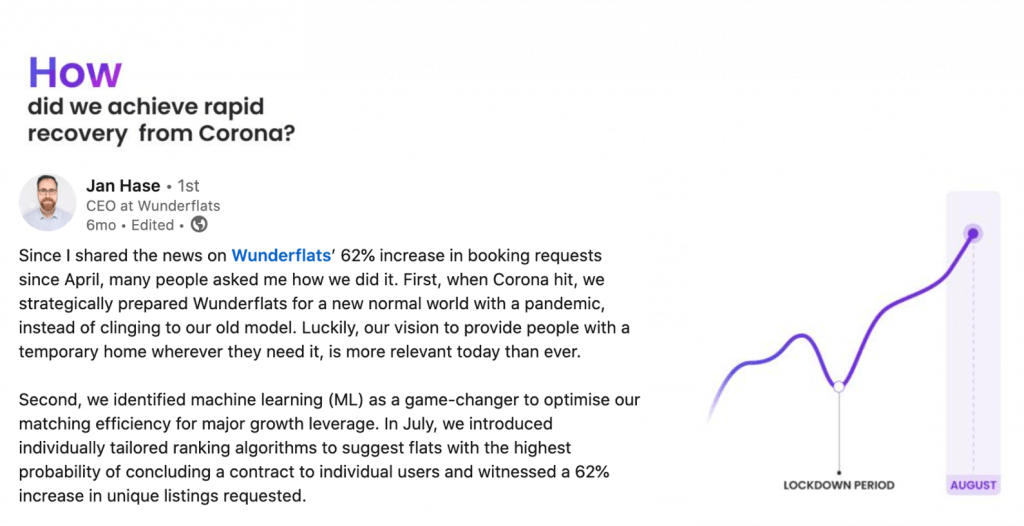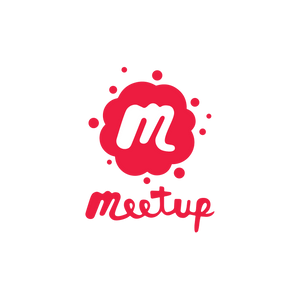Wunderflats: How ML enabled a 62% increase in marketplace booking requests
Incorporating ML in Wunderflats’ platform
Machine Learning can be a gamechanger for marketplaces. Below you can find out how we helped Berlin based wunderflats with integrating ML into their platform. But let’s start with the result, a post of their CEO (Jan Hase):

Everyone should be able to live and work anywhere, anytime – this is the vision of Wunderflats, Germany’s no. 1 marketplace for temporary furnished housing. After the company collected a Series B investment of €8 million in 2019, they also doubled down on their analytics efforts with their dedicated BI data team. In 2020, the usage of data at Wunderflats matured to the next level with a new ambition: incorporating machine learning into the platform. After execution of the ML audit, the most promising use case was selected: Wunderflats’ ranking engine. Being a platform that matches supply and demand, this use case is central in the business of Wunderflats. Read here how Wunderflats started their ML journey with us, ending up in a 62% increase in unique listings requested!
Jan Hase and Arkadi Jampolski founded Wunderflats in 2014. On the platform, tenants can book fully equipped apartments from a rental period of one month at an all-inclusive price. The company hired Kevin Jolly in 2019 with the mission to build a highly professional BI team from scratch. The year after, Wunderflats started to work on incorporating machine learning in the platform together with Enjins. In the following interview, Jan Hase (CEO) and Kevin Jolly (Team lead BI) explain why machine learning will become a key asset for Wunderflats’ core business decisions and analyses and why they chose to work with Enjins.
Jan, what brought you to founding Wunderflats in 2014?
Initially, Arkadi and I worked on an exchange platform for student apartments called “rooming”. However, our claim is to enable anyone to live and work anywhere, anytime. Therefore, we pivoted to focus not just on students, but also on young professionals, consultants, and expats. We want to revolutionize the housing industry and reduce geographical barriers by deeply focussing on our users’ needs. For this, we create the best experience for letting and renting apartments there is.
Kevin, in 2019 you joined Wunderflats as the BI Manager. How did you set up the team and create a roadmap to move forwards?
It was very important for us to get the foundation of data right in Wunderflats. Therefore, a key priority was to ensure that we had a scalable data infrastructure in place that would enable us to collect, store and transform data that is generated from every corner of the organisation and the product. We’ve built a strong and unique setup that is very attractive to Data Analysts and Data Engineers. This strategy allowed us to hire some of the best people on the market. Together, we scaled our data warehouse one step further and introduced tools enabling strategic analytics and decision-making for the entire company.
Once the department was mature enough talent-wise, the next logical step was to advance the capabilities of our product by introducing machine learning. With all data we have available to us, the use of machine learning will help us realize exceptional matching qualities. We now propose listings with the highest probability of concluding a contract to each user.
You started to work with Enjins in early 2020 with the Machine Learning audit. What were your considerations to start with a company like Enjins rather than hiring a Machine Learning engineer from the start?
The possibility of performing an audit on the current state of data in the platform helped us understand the way Enjins executes as a ML Expert. Once we were convinced that the work was delivered with a lot of attention to detail, we could trust that the implementation of the initial ML infrastructure would be thoroughly managed.
ML is an ecosystem that takes time and substantial attention to develop. We did consider looking for an ML Engineer in the beginning, but we soon realized that an audit with Enjins would help us understand the exact level of maturity we needed to attain before pursuing or expanding ML capabilities. ML is an expensive pursuit, and it is important to get it right the first time.
Based on the ML audit, we decided together that we should start the development of Wunderflats’ ranking engine. Why is this project so important for Wunderflats?
A marketplace platform for apartments like Wunderflats increases the liquidity of the listings that we offer to potential tenants. Discoverability is then an issue that has to be solved. This is where the effective use of data comes into the picture. Offering the right apartment to the tenant up-front improves the odds that both landlords and tenants are satisfied with the result. Also, this system minimizes the time required to conclude a contract. ML is the technology that can lead us to this crucial increase in match efficiency.
During the audit and the development of the ranking engine, we worked together in close cooperation with your team. How did you guys experience this?
The overall process was well structured from the start, with deadlines being met on all occasions. It was great for us to know the long-term implications of actions that we could take. We also perceived the ROI and Business cases of multiple projects as very insightful, and they helped us decide on pursuing the development of the ranking engine.
What are the long-term ambitions now in terms of machine learning for Wunderflats?
Our marketplace model is now undergoing a fundamental transformation. AI-driven products have been a significant driving force in that change. With Wunderflats, our goal remains to help landlords and tenants find the best possible matching experience, and we foresee AI playing a significant role in future feature developments along that way.
Results after the work with Enjins
The developed ranking engine at Wunderflats was delivered in multiple steps, to assure first business impact within a 6-month period. In August 2020, we realised a 62% increase in booking requests together with the Wunderflats team. Those great first results led to further joined development of the ranking engine with multiple and more complex models. All with the goal to further balance the supply and demand of the Wunderflats marketplace!
Would you like to stay updated with the latest cases, events and developments around ML & AI? Please follow our LinkedIn page!
Please fill in your e-mail and we'll update you when we have new content!

 Follow us on LinkedIn!
Follow us on LinkedIn! Check out our Meetup group!
Check out our Meetup group!